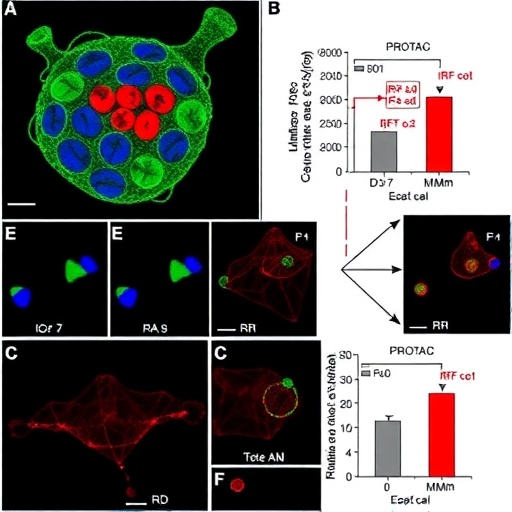In a groundbreaking study published in BMC Cancer, researchers have unveiled the remarkable efficacy of targeting the oncogenic regulator mdm2 through PROteolysis TArgeting Chimeras (PROTACs) in various breast cancer cell lines, including those resistant to abemaciclib and harboring both wildtype and mutated forms of p53. This innovative therapeutic strategy represents a significant leap forward in the battle against estrogen receptor-positive breast cancers, a prevalent and often challenging subtype to treat.
Mdm2, known scientifically as the human double minute 2 homolog (hdm2), is a critical negative regulator of the tumor suppressor protein p53. Ordinarily, mdm2 modulates p53 activity by tagging it for degradation under normal cellular conditions, thus maintaining cellular homeostasis. However, in many cancers, overexpression of mdm2 leads to the suppression of p53’s tumor-suppressive functions, allowing unchecked cellular proliferation and tumor growth. Consequently, mdm2 has long been regarded as a promising molecular target for cancer therapy.
Despite its potential, direct inhibition of mdm2 using small-molecule inhibitors has faced significant challenges. Traditional mdm2 inhibitors, such as AMG-232, while specific, often result in suboptimal therapeutic outcomes and can elicit adverse effects. These limitations underline a growing need for more precise and effective approaches to target mdm2 in cancer cells, particularly in breast cancers that often develop resistance to existing therapies.
The study spearheaded by Goerg and colleagues explores the use of PROTAC technology to degrade mdm2 rather than merely inhibit its function. PROTACs are bifunctional molecules designed to harness the cell’s own ubiquitin-proteasome system for targeted protein degradation. By simultaneously binding to a target protein and an E3 ubiquitin ligase, PROTACs induce the selective ubiquitination and subsequent destruction of pathological proteins. This therapeutic modality promises heightened specificity, reduction in off-target effects, and effective elimination of disease-driving proteins.
In their series of in vitro experiments, the researchers compared the effects of the mdm2 inhibitor AMG-232 with those of an mdm2-targeting PROTAC in several estrogen receptor-positive breast cancer cell lines. These included p53 wildtype MCF-7 cells that were either sensitive or resistant to abemaciclib, a CDK4/6 inhibitor approved for advanced breast cancer, as well as the p53-mutated T-47D cell line. This comprehensive approach allowed for a robust evaluation across different genotypic and therapeutic resistance profiles common in clinical breast cancer cases.
The results were striking. PROTAC treatment led to a pronounced attenuation of cell proliferation in all tested cell lines, outperforming mdm2 inhibition by AMG-232 across the board. Notably, the degradation of mdm2 by PROTAC was effective even in cells harboring p53 mutations, which are generally less responsive to agents that restore p53 functionality. This finding suggests that PROTAC-mediated mdm2 degradation might circumvent the limitations posed by dysfunctional p53 in cancer cells.
Further molecular analyses revealed that PROTAC-induced degradation of mdm2 triggered significant alterations in proliferation-associated signaling pathways. These included modulation of p73, a p53 family member known to compensate for p53 loss, as well as changes in retinoblastoma protein (Rb) activity and the transcription factor E2F1. Collectively, these disruptions converge to halt cell cycle progression and suppress tumor growth, highlighting the multifaceted impact of mdm2-targeting PROTACs on cancer cell biology.
Intriguingly, the study also investigated whether PROTAC treatment influenced the expression of immune-related markers. They observed a notable downregulation of major histocompatibility complex class I (MHC-I) and CD276, an immune checkpoint protein. This shift in immune marker expression may have important ramifications for anti-tumor immunity and suggests potential avenues for combining PROTAC-based therapies with immunotherapeutic strategies.
The superiority of PROTACs over traditional mdm2 inhibitors underscores a fundamental paradigm shift in targeted cancer therapy—transitioning from inhibition to degradation of oncogenic drivers. By physically eliminating mdm2, PROTACs bypass compensatory feedback loops and resistance mechanisms that often undermine inhibitor efficacy. Such an approach could provide durable therapeutic responses even in stubborn, treatment-resistant breast cancers.
Moreover, the application of PROTAC technology extends beyond mdm2, holding promise for a wide spectrum of undruggable targets in oncology. The methodology refined in this study offers a blueprint for tailoring PROTACs to degrade pivotal proteins implicated in cancer initiation and progression, thereby expanding the arsenal of targeted therapies available to clinicians.
Looking ahead, the authors emphasize the necessity of validating these findings in appropriate preclinical in vivo models, such as humanized tumor mice, that recapitulate the tumor microenvironment and immune interactions more faithfully than cell culture alone. Successful translation of mdm2-targeting PROTACs into animal models and eventually clinical trials will mark a pivotal advancement in breast cancer therapeutics.
In summary, this elegant study by Goerg et al. delivers compelling evidence that PROTAC-induced degradation of mdm2 is a highly effective strategy to suppress proliferation in estrogen receptor-positive breast cancer cells, regardless of p53 mutation status or resistance to abemaciclib. By illuminating the molecular underpinnings and therapeutic potential of mdm2 degraders, the research paves the way for the development of novel, potent treatments that may revolutionize the management of breast cancer.
The utilization of PROTAC technology represents a frontier in personalized oncology, offering hope for overcoming longstanding challenges such as drug resistance, toxicity, and limited efficacy of conventional inhibitors. As the field advances, such targeted degraders may well reshape the landscape of cancer care, delivering more precise, effective, and durable therapeutic outcomes for patients worldwide.
This study not only deepens our understanding of breast cancer biology but also sets a new standard for therapeutic innovation. Harnessing the cell’s own protein quality control systems to dismantle key oncogenic proteins heralds a promising era of molecularly tailored therapies with the potential to save lives and transform prognoses in breast cancer.
Subject of Research: Targeting mdm2 via PROTAC-mediated degradation in estrogen receptor-positive breast cancer cell lines, including abemaciclib-resistant and p53-mutated variants.
Article Title: Mdm2 targeting via PROteolysis TArgeting Chimeras (PROTAC) is efficient in p53 wildtype, p53-mutated, and abemaciclib-resistant estrogen receptor-positive cell lines and superior to mdm2 inhibition.
Article References:
Goerg, A., Piendl, G., Albert, V. et al. Mdm2 targeting via PROteolysis TArgeting Chimeras (PROTAC) is efficient in p53 wildtype, p53-mutated, and abemaciclib-resistant estrogen receptor-positive cell lines and superior to mdm2 inhibition. BMC Cancer 25, 978 (2025). https://doi.org/10.1186/s12885-025-14361-z
Image Credits: Scienmag.com




